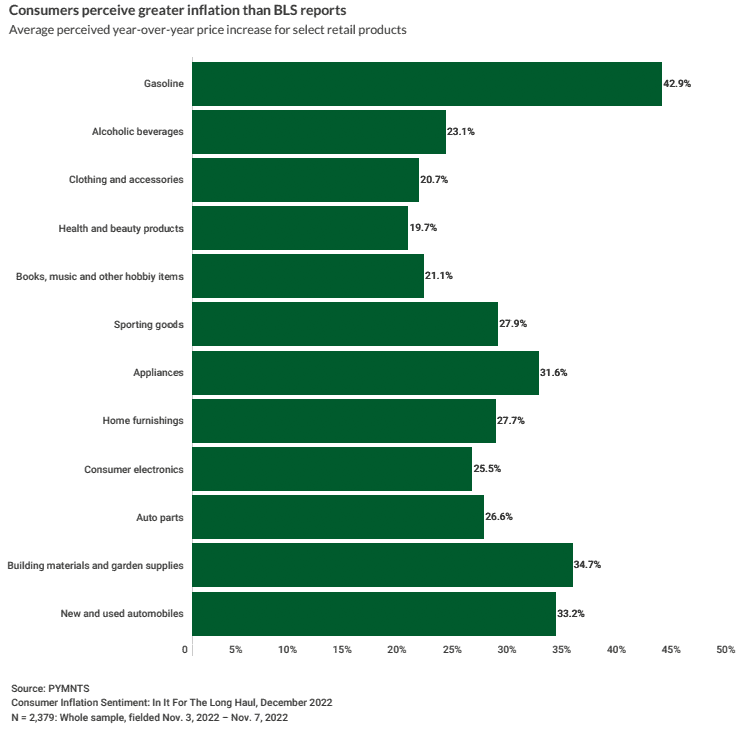Inflation Rate Eases but Cost of Food and Essentials Remains High

The inflation rate may have peaked, but consumer sentiment remains low.
The Bureau of Labor Statistics published November’s Consumer Price Index (CPI) Tuesday (Dec. 13). To the surprise of many economists, the overall index beat estimations, slowing to 7.1% year over year instead of the predicted 7.3%. The biggest declines over the past month were in piped natural gas service (-3.5%), used cars and trucks (-2.9%) and airline fares (-3%). The largest increases over the month were in fuel oil (1.7%), fruits and vegetables (1.4%) and motor vehicles maintenance/repair (1.3%).
A 7.1% cost-of-living increase is dramatic for many. However, consumers believe that percentage to be much higher. PYMNTS’ latest monthly study of consumer sentiment, “Consumer Inflation Sentiment: In It for the Long Haul,” demonstrated the divide between customer perception and reality.

This mismatch of perception versus reality may be partially attributed to wage stagnation instead of rising costs. The consequence of retailers relying solely on officially published figures and ignoring consumer sentiment could result in revenue loss as customers seek to stretch their budgets. Eighty-eight percent of surveyed consumers reported that their paychecks have not remained in step with rising inflation, and over half expect this inflationary cycle to last until June 2024. Whether or not their impressions are correct, consumers said they believe current economic conditions will likely continue for “the long haul.”
This consumer sentiment has not moved much since the pandemic began. As PYMNTS’ Karen Webster explained, “These inflation expectations are important for macroeconomic policy because they suggest that the Fed has a long way to go to convince consumers … that their salary increases and job offers don’t need to cover rising costs of living.”
Customers’ belief that cost increases are higher than they actually are may also be due to retailers’ price variations. Matt Pavich, senior director of retail innovation at Revionics, told PYMNTS that retail prices can differ depending on the store.
“It’s the Wild West of retail pricing this holiday season, with inventory mismatch fueling a wide range of price-tag decisions,” he said.
Embarking on a campaign to change consumer sentiment may very well prove fruitless. Instead, retailers may consider looking to customer loyalty and retention strategies. Supermarkets are not immune to inflation, with food prices rising 12% in the past year. And, as with retailers in other sectors, many customers are willing to switch merchants for discounts.
Grocers have accommodated this shift with various approaches. These include marking down items close to sell-by dates or expanding inventory to include items not normally found at a supermarket, like Christmas trees. Large chains, such as Kroger and BJ’s, are introducing such initiatives as expanded in-store media and offering marketing initiatives for brands they carry.
Retailers in other sectors may implement similar strategies. For example, clothing stores could offer deep discounts on last season’s sales to promote in-store purchases of other items, or a cookware shop could sell adjacent items such as spices or other dry goods.
Some retailers are already embracing forward-looking technology in their eCommerce recommendations.
“When you ask for a recommendation, you don’t ask a complete stranger,” Alexandre Robicquet, CEO and co-founder of recommendation engine Crossing Minds, told Webster in an interview. “You ask someone that knows you and has an intimate understanding of what motivates and drives you.”
This is a similar mindset to intent-driven recommendations. However, instead of relying on a friend for their opinion, these artificial intelligence (AI)-powered engines make suggestions based on consumers’ recent shopping behavior.
There is a wide range of solutions for retailers to accommodate and benefit from consumers’ current gloomy economic outlook. However, if consumers’ perception about their purchasing power remains worse than the official figures, it may impact their willingness to spend. Ignoring customer sentiment completely by solely focusing on the government-reported numbers could be at retailers’ own peril.
For all PYMNTS retail coverage, subscribe to the daily Retail Newsletter.